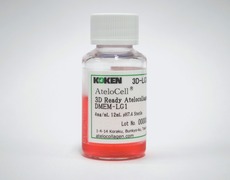Newsletters
A Three-Minute Guide: Applications of the ubiquitous collagen solution
23 June 2025
| |
|
|
|
|
A Three-Minute Guide: Applications of the ubiquitous collagen solution
Researcher’s all-rounder mate in a single bottle
|
|
As researchers working in a lab, we may all have seen a bottle of collagen solution in the refrigerator at least once. Collagen, which is the main component of the extracellular matrix, accounts for about 30% of the proteins in living organisms, and it is used in many studies as a scaffold to which various cells adhere.
In this issue, we will introduce three typical applications of collagen solution along with relevant research papers.
|
|

|
An in vitro culture platform to study the extracellular matrix remodeling potential of human mesenchymal stem cells.
Kim MH, et al.
Acta Biomater. 2023 Oct 15;170:376-388. PMID: 37619896.
Flasks were coated with high-density collagen and cultured with mesenchymal stem cells (MSCs).
This method was suggested to be more suitable for evaluating the extracellular matrix remodeling potential of MSCs than the conventional method.
|
|
The cGAS-STING pathway drives type I IFN immunopathology in COVID-19.
Domizio JD, et al.
Nature. 2022 Mar;603(7899):145-151. PMID: 35045565.
A lung-on-chip device was coated with collagen and seeded with alveolar epithelial cells, vascular endothelial cells, and macrophages. A SARS-CoV-2 infection model was created to identify the mechanism underlying the immunopathology of COVID-19.
|
|
|
|
|
|

|
Tissue-scale tensional homeostasis in skin regulates structure and physiological function.
Kimura S, et al.
Commun Biol. 2020 Oct 30;3(1):637. PMID: 33127987.
A novel skin model was created by seeding keratinocytes on a collagen gel containing two layers of fibroblasts. This model exhibited a greater responsiveness to all-trans retinoic acid and other substances than the conventional model.
|
|
|
Collagen lattice model, populated with heterogeneous cancer-associated fibroblasts, facilitates advanced reconstruction of pancreatic cancer microenvironment.
Song X, et al.
Int J Mol Sci. 2024 Mar 27;25(7):3740. PMID: 38612551
Pancreatic cancer cells and cancer-associated fibroblasts (CAFs) were cocultured in collagen gels to create a cancer microenvironment model, which is suggested to have potential applications in drug screening.
|
|
|
|
|
|

|
Early invasion of the bladder wall by solitary bacteria protects UPEC from antibiotics and neutrophil swarms in an organoid model.
Sharma K, et al.
Cell Rep. 2021 Jul 20;36(3):109351. PMID: 34289360.
Bladder organoids injected with Escherichia coli were cultured in collagen gels to create an infection model. Imaging revealed that subpopulations of bacteria that are resistant to antibiotics were found at the early stages of infection.
|
|
|
Suppression of the epithelial-mesenchymal transition and maintenance of the liver functions in primary hepatocytes through dispersion culture within a dome-shaped collagen matrix.
Tonooka Y, et al.
Biol Pharm Bull. 2024;47(7):1241-1247. PMID: 38945897.
A 3D culture of primary hepatocytes in a dome-shaped collagen gel was shown to maintain liver function for 14 days while suppressing epithelial–mesenchymal transition .
|
|
|
|
|
|
Researcher’s all-rounder mate in a single bottle

|
Collagen acidic solutions 50 mL/bottle
|
|
|
|
|
|
|
Ready-to-use products are recommended for organoid and 3D cultures

|
|
|
3D ready atelocollagen 12 mL/bottle
|
|
|
|
|
|
|
|
|
|
We plan to participate in the 7th Regenerative Medicine Expo (INTERPHEX Week) in July 2025. We will also have an exhibitors’ presentation on the skin model studies. Please visit us at the venue.
7th Regenerative Medicine Expo Tokyo
Date: July 9 (Wednesday) to July 11 (Friday), 2025
Venue: West Hall 2, 1F West Exhibition Hall, Tokyo Big Sight
Booth: W6-16
Exhibitor’s presentation
Date: July 9 (Wednesday), 2025
Time: 10:50–11:20
Venue: Exhibitors’ Presentation Venue 5
Topic: Reduce the culture period by 50%! Rapid maturation of epidermal models – Also full-thickness models
|
|
|